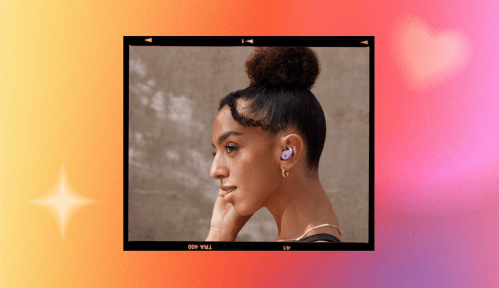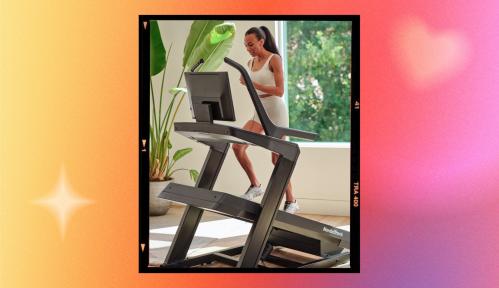Our editors independently select these products. Making a purchase through our links may earn Well+Good a commission
Heart-Rate Zone Training Makes *You* the Main Metric on the MYX Bike
The MYX bike utilizes heart-rate-zone training to make you the main metric when riding it. (Plus, all the stuff to know before buying.)

Shopping for a high-dollar piece of fitness equipment like a connected cardio bike should qualify as a major a life event. Like moving, having a baby, or changing jobs, it requires plenty of research, it’s a big expense, and it’s stupidly stressful. And with so many options out there, the feat of winding up with a bike you love (and will use daily) can—without cliche—truly feel tougher than in the past when options were limited. So while I’ll give you the intel you need to know before buying a MYX Bike, let me boil it down quickly for those who are road-weary from reading reviews: The MYX bike doesn’t display RPMs, resistance, or effort metrics. The classes that accompany the bike push you to ride based on your heart rate and how hard your body is working at any given moment. If you’re focused on your progress versus your output, this could be the bike for you.
The rise of at-home connected fitness equipment (those bike, treads, rowers, etc. that have a screen attached to them and offer accompanying classes for people to follow along to) is often traced back directly to Peloton; however, brands like NordicTrack have long been utilizing screens to wind you through different locales as you run or spin. “When I talk about this category, I like to remind people that home fitness equipment and home fitness content are not new,” Jon Canarick, managing partner at North Castle Partners, a VC group that invested in the connected bike brand Echelon previously told us for our Well+Good 2021 Trends report. “What has changed is bringing those two things together and creating a better experience.”
Most bikes take the same approach to at-home connected fitness, but with its personalized heart-rate zone training, the MYX bike offers something a little different. To see if it’s for you, keep on scrolling.
What should I know about the MYX bike?
Instead of using RPMs (speed), resistance (heaviness), or effort (those two combined) metrics to tell you how hard your body is working at a given time, the MYX bike utilizes your heart rate to keep you in different zones throughout the workout. In using your body’s own biometrics, the brand believes that you’re better able to know when to push it and when to pull back.
“We included the metrics [customers told us that they] found most approachable to get them started, such as calories, BPM, and heart-rate zones,” says Heberto “Herbie” Calves, MYXfitness president. “We found the majority of our members felt put-off by the competitive nature of the fitness industry and wanted an ally in their journeys to health.” There’s no leaderboard, no live classes, and really no pressure to feel in competition with anyone but yourself. That’s a plus for some, but for those who are motivated by the energy of others, you might feel like you’re missing out.
The bike itself feels very much like other at-home bikes, which is to say that it’s certainly sturdy but feels a bit less “pro,” so to speak, than studio bikes, which are required to take constant wear from a revolving set of riders. It has an adjustable seat to account for longer legs. The large touch screen also moves so that you can be comfortable when doing standing moves on the bike. The bike is roughly four-and-a-half feet long and just shy of two feet wide, and the flywheel goes up to 41 pounds. It plugs into an outlet to power the touchscreen (but you can also ride with the bike unplugged if you’re just going it alone). The pedals come with both SPD clips on one side and sneaker cages on the other, so you don’t need to have clip-in shoes to ride, but it does make the experience smoother.
How much does the MYX bike cost?

MYX bike — $1,299.00
If you purchase the MYX bike alone, the ticket price is $1299; however, if you opt for the MYX Plus, which comes with hand weights, a kettlebell, resistance bands, and foam roller to do some of the off-bike exercises, the cost ticks up to $1499. Both bikes come with a corresponding Polar OH1 Heart Rate Monitor, which wraps around your arm (it’s pretty slim so it doesn’t get in the way of the workouts). At the moment, there’s free shipping, assembly, and delivery, which normally rings in at $250.
Like with many connected fitness platforms, you need to buy the bike, but you also need to purchase a subscription membership to access the platform’s content. MYX’s content library costs $29 per month, so you can expect from the outset to spend roughly an additional $350 per year to access the classes that help you make the most of the bike.
Taking all of this together, MYX is solidly in the middle of the pack when it comes to pricing. Peloton’s bike is $1,895 and SoulCycle’s is $2,500, but there are less expensive connected bikes like Echelon, which rings in at $495 for the most basic model. Most all of them come with subscription plans to their own content, which varies in price but is an added expense.
What are the workouts like?
If you’ve ever gone to a class like Orangetheory, where your heart is asked to work in certain “zones,” then the MYX style of class may feel familiar. Whether you’re taking a mat or spin cardio class, you’re told to stay in certain zones, which indicate how hard your body is working. Instructors will tell you to turn the resistance higher or speed up, but your body is really the main metric that you’re taking into consideration, which actually feels like a very athlete-forward way to think about spinning.
“Our goal is to help people work out smarter and simpler, which is why we put an emphasis on personalized heart-rate training. According to the American College of Medicine, the more effective method of training is to work out with varying intensities to achieve your goals,” says Calves.
In any given workout, there are three zones to know. The blue zone is where your heart rate most resembles your heart rate at rest. It’s the zone wherein instructors will have you take active recovery, and as the brand puts it, “you could be there for hours.” The green zone is moderate-to-hard intensity, and it’s the heart-rate zone that most MYX classes frequently stay in. The orange zone is high-intensity work, which is meant to max out your heart rate and push you to limits that you can really only sustain for super-short bursts of time.
Before you start, you have to calibrate your heart-rate monitor, and like other pieces of fitness equipment, it gets to know your body over time, so as you wear it, it gets smarter. It’s important to note that all of these heart-rate zones are unique to you, so while your brother, sister, mother, father, friend-from-work might be working differently than you are, you’re working the best possible way for your body.
When you hop on the bike, instructors will take you through pretty standard workouts that feel more like you’re exercising with a personal trainer than in a class with other people. One feature that I really like about the MYX bike is that you can turn up or down both the volume of the instructor’s voice and the music, so if you’re really in the zone and just want to ride to the music, you can; or conversely, if you really want to listen to cues and perfect your form, you can do that, too.
According to Calves, roughly 60 percent of the workouts that people do on the MYX bike are 20 minutes or less, and most users are doing an average of 15 workouts each month. Most of the rides on the bike do seem to follow this shorter time frame so you can knock one out on a lunch break or you can snap a few together to make a longer workout. Each ride is marked with the intensity level, so you can also choose based on what you want for the day.
Is it worth it?
Totally. If you’re looking for a bike that centers you, then MYX is a great option. Just make sure that you’re not interested in the metrics and the frills that other bikes center, because the MYX truly is different, and will have you working out with heart-rate zone training in mind. But as Calves says: “Everybody’s body and heart is different, so this style of training helps to minimize injuries and fatigue so you can create a sustainable fitness routine that not only works, but lasts.”
One of the biggest barriers keeping most of us from moving is going too hard, too soon and getting fatigue from that. Creating a sustainable workout that you can keep up for the long run should take into consideration your body and how you work. From there, it’s one foot in front of the other.
Oh hi! You look like someone who loves free workouts, discounts for cult-fave wellness brands, and exclusive Well+Good content. Sign up for Well+, our online community of wellness insiders, and unlock your rewards instantly.
Sign up for the Well+Good SHOP Newsletter
Get exclusive deals on wellness, beauty, fitness, and food products that have been hand-picked by our editors.
Got it, you've been added to our email list.










